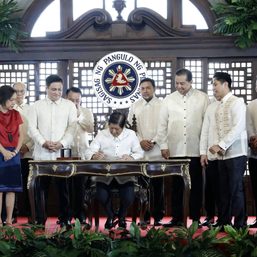SUMMARY
This is AI generated summarization, which may have errors. For context, always refer to the full article.
![[In This Economy] What foreigners are saying about the Maharlika fund](https://www.rappler.com/tachyon/2023/12/TL-foreigners-maharlika-fund-dec-1-2023.jpg)
It’s been almost a year since the House of Representatives approved the Maharlika Investment Fund bill with an overwhelming majority of 279 votes. Only 6 voted against it.
Although certainly well-intentioned, Maharlika became a lot worse as it passed through the Senate. As they say, the path to hell is paved with good intentions.
Now, even foreigners are sounding the alarm.
Ian Murphy, a policy analyst with the consulting firm Safe Spaces, wrote on November 27 that integrity and trust are crucial for the success of Maharlika. He elaborated: “With the public already skeptical about transparency and accountability, political leaders will have to prove their good intentions by creating good institutional structures, oversight, and reporting.”
Murphy added that the recent amendments to Maharlika’s implementing rules and regulations (IRR) “have not fully dispelled fears that political interests could take precedence over national interests.” (READ: [In This Economy] How Marcos is politicizing the Maharlika fund)
On the same day, incidentally, the ASEAN Macroeconomic Research Office or AMRO, a Singapore-based organization that regularly does regional economic surveillance, published their Annual Consultation Report on the Philippines.
Apart from dissecting the latest in the Philippine economy in that report, they likewise flagged some issues concerning Maharlika.
In a nutshell, they said: “While the new MIF Act has laid down a strong legal framework, at the operational level, the authorities should clearly define its role in infrastructure investment with appropriate governance stipulated to avoid misuse of funds. The MIF should be run by professionals and the board should comprise independent directors.”
They hit the nail on its head, and captured the essential points that my colleagues and I earlier made in a UP School of Economics discussion paper published on June 6. But let’s parse what AMRO said.
Governance risks
First, they, too, believe that Maharlika is not a sovereign wealth fund in its true sense.
They said: “Typical sovereign wealth funds often invest overseas using the funds derived from i) surplus revenue from oil and other industries that deal with natural resources, as in the case of the United Arab Emirates’ Abu Dhabi Investment Authority, or ii) fiscal surpluses as in the case of Singapore’s Government Investment Corporation. However, the MIF is a national investment fund mainly investing within the country to support national development strategies, similar to the Indonesia Investment Authority, and Temasek Holdings.”
This is key because even Maharlika’s proponents don’t truly know what Maharlika is. They keep using the term “sovereign wealth fund,” when in fact, it’s aptly called a “strategic investment fund.” That makes for a whale of a difference.
Second, AMRO acknowledged that “there could be a risk in terms of governance, especially if the fund’s role in infrastructure investment is not clearly defined, which could lead to misuse of funds and lack of accountability.”
This could mean many things, such as diverting funds for unintended purposes or favoring particular companies or business groups. These, in turn, could lead to poor investment decisions or even corruption.
Opportunity costs
Third, AMRO said, “There could be a risk that the different goals might be at odds with each other in some investments, for instance, there could be a trade-off between the rate of return and the public good nature of certain projects.”
In his first press conference, even Rafael Consing Jr., Maharlika’s first president-CEO, acknowledged that it will take many decades before Maharlika takes off and reaps returns. But in the meantime, funds will be taken away from the public coffers, funds that could be spent on more immediate uses like building schools or hospitals or social aid programs. The opportunity costs are so high.
Related to this, AMRO flagged that “funds contributed by the government agencies could crowd out planned expenditure in other areas.”
Here they are likely talking about the P50-billion contribution of Land Bank of the Philippines (LBP), the P25-billion contribution of the Development Bank of the Philippines (DBP), and the P50-billion contribution of the national government.
By taking away capital from LBP and DBP, for example, these state-owned banks lose much ability to lend to their clientele, which includes farmers, fisherfolk, and cooperatives in rural settings. After all, these banks’ core mandate is to spur rural and agricultural development. In a very real sense, then, Maharlika robs people in rural areas of the ability to grow their small business operations.
There’s also a cost to getting all the net earnings of the Bangko Sentral ng Pilipinas (BSP) in Maharlika’s first two years of operations. Instead of using that money to grow the BSP’s capital and strengthen its ability to fulfill its mandate (of ensuring low and stable prices and regulating banks), such money will be used as part of Maharlika’s seed capital – for dubious returns that, if any at all, won’t be reaped until decades from now.
Risks to banks
AMRO also pointed out a crucial and underappreciated risk: “although the contributions to the Maharlika’s capital from government financial institutions (GFIs) are relatively small compared with the size of their investible funds, there could be some impact on the institutions’ financial position in the event of losses.”
Since late last year economists have pointed out that Maharlika will drain capital away from state-owned banks, making them unable to meet the capital requirements set by the BSP and international banking regulations.
More importantly, this leaves them vulnerable to all sorts of problems and risks, including penalties from the BSP, the need to raise more capital, reduced confidence from the market and their clientele, lower profitability, credit rating downgrades, and vulnerability in the event of contagions and banking crises.
All in all, Maharlika weakens rather than strengthens the banking sector. That’s not good.
This is precisely why LBP and DBP sought “regulatory relief” (basically exemptions) from the BSP in October, foreseeing that both won’t be able to meet the BSP’s capital requirements.
Recall that in September, both LBP and DBP also remitted to the Treasury their respective contributions to Maharlika – which is odd since until now, there’s formally no Maharlika Investment Corporation to speak of.
The problem is that the original IRR of Maharlika stated that the contributions of LBP and DBP “shall be deposited to the account of the Treasurer of the Philippines for the benefit of the MIC” fivedays from the effectivity of the IRR. Why the rush?
After President Ferdinand Marcos Jr. suspended the implementation of Maharlika in October, DBP wanted to get their money back. Said Michael de Jesus, DBP’s president and CEO, “We’ve formally requested that the funds could be returned. We just wrote a formal letter asking (for the return of the funds). It’s only proper we have to do that.”
That concern is valid. Without any MIC yet, that huge amount of money will just sit idly – a shame when ordinary Filipinos can already be benefitting from it now.
In conclusion, AMRO held out some optimism for Maharlika, saying it “has the potential to be a successfully managed national investment fund.” But implementation is key, and there’s a need for “rigorous due diligence” and a “robust risk management framework.”
If even outsiders can see the writing on the wall, why can’t Marcos and fellow Maharlika proponents see it? More importantly, how can we make them recognize the risks they have so willfully downplayed and ignored for more than a year now? – Rappler.com
JC Punongbayan, PhD is an assistant professor at the UP School of Economics and the author of False Nostalgia: The Marcos “Golden Age” Myths and How to Debunk Them. JC’s views are independent of his affiliations. Follow him on Twitter (@jcpunongbayan) and Usapang Econ Podcast.
Add a comment
How does this make you feel?






![[ANALYSIS] Economists vs Maharlika: Some key points](https://www.rappler.com/tachyon/2023/06/maharlika-fund-TL-june-9-2023.jpg?resize=257%2C257&crop=436px%2C0px%2C1080px%2C1080px)

![[In This Economy] Marcos’ POGO ban is popular, but will it work?](https://www.rappler.com/tachyon/2024/07/thought-leaders-marcos-pogo-ban.jpg?resize=257%2C257&crop=255px%2C0px%2C720px%2C720px)
![[Rappler Investigates] POGOs no-go as Typhoon Carina exits](https://www.rappler.com/tachyon/2024/07/newsletter-graphics-carina-pogo.jpg?resize=257%2C257&crop=424px%2C0px%2C1080px%2C1080px)





![[Just Saying] SONA 2024: Some disturbing points](https://www.rappler.com/tachyon/2024/07/TL-marcos-sona-points-july-23-2024.jpg?resize=257%2C257&crop=335px%2C0px%2C720px%2C720px)

![[EDITORIAL] Apat na taon na lang Ginoong Marcos, ‘di na puwede ang papetiks-petiks](https://www.rappler.com/tachyon/2024/07/animated-bongbong-marcos-2024-sona-day-carousel.jpg?resize=257%2C257&crop=280px%2C0px%2C720px%2C720px)
![[In This Economy] Delulunomics: Kailan magiging upper-middle income country ang Pilipinas?](https://www.rappler.com/tachyon/2024/07/in-this-economy-upper-middle-income-country.jpg?resize=257%2C257&crop=421px%2C0px%2C1080px%2C1080px)

![[EDITORIAL] Marcos Year 2: Hilong-talilong](https://www.rappler.com/tachyon/2024/07/animated-bongbong-marcos-2nd-sona-carousel.jpg?resize=257%2C257&crop=136px%2C0px%2C720px%2C720px)
![[Newspoint] A fighting presence](https://www.rappler.com/tachyon/2024/07/thought-leaders-a-fighting-presence.jpg?resize=257%2C257&crop=441px%2C0px%2C1080px%2C1080px)
There are no comments yet. Add your comment to start the conversation.